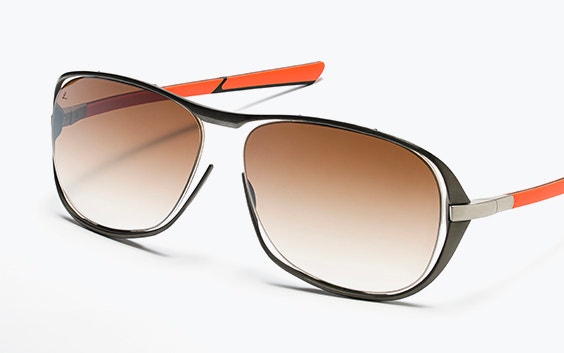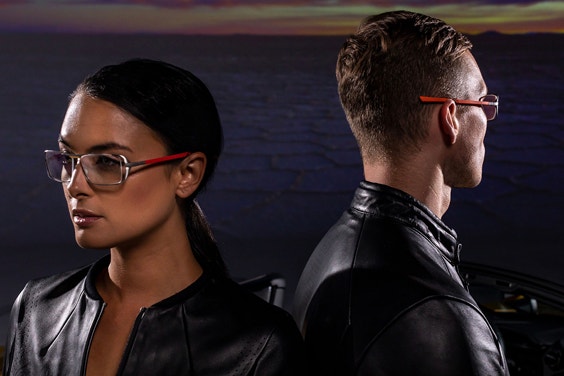CASE STUDY
Reinventing the Frame: The McLaren Vision Collection

How a luxury brand, eyewear designer, and company of innovators worked together to find an entirely new solution for creating a high-end, 3D-printed metal eyewear collection — and brought a vision that was 20 years in the making to life.
Seeing eye to eye
“On paper, and even on screen with 3D digital renderings, you can see how a design should look. Holding it in your hands and seeing how it rests on the face, you can go ‘yes, that’s the one!’.” When a brand like McLaren, known for ultimate luxury engineering, extend their DNA to a new offering, customers expect to see the marque’s essence reflected in this latest endeavor brought to market.
For McLaren, this means employing supercar imperatives and cutting-edge technologies to guarantee ultimate performance. In the case of the collaboration with leading eyewear manufacturer L’Amy, designer Sébastien Brusset, and 3D printing innovators Materialise, this culminated in the highly acclaimed McLaren Vision Collection. Lauded as the Frame Technological Innovation of the year at the 2018 Silmo d’Or Awards in Paris, this collection of optical and sunglasses fully represents the McLaren ethos: innovation, endurance, no compromises.
In order to rise to the challenge of meeting the McLaren standard in precision manufacturing, L’Amy and Sébastien Brusset turned to Materialise to support them in bringing their ambitious vision to life: creating a high performance, high endurance, fully customizable eyewear collection with metal 3D printing.
A vision comes to life
The concept behind the McLaren frame that ultimately won a prestigious Silmo d’Or Award was a long time in the making. Over 20 years, in fact, when the original concept first came to designer Sébastien Brusset. At the time, the trained optician-turned-eyewear designer found it surprising that lenses were set in very rigid structures that created tension between the lens and frame, thus making the product less resistant to shock and less comfortable for the wearer. In an effort to find a way to create eyewear that is more lightweight, more durable, and better adapted to human physiognomy, Sébastien set an ambitious challenge for himself: “Rethinking from scratch what a frame is and how it is constructed.”
The designer envisioned a strong, lightweight structure, organic and minimalistic in terms of its aesthetic, with blades that fit the customer’s nose bridge perfectly. But even as this notion of deconstructing and completely rethinking eyewear came to him, Sébastien also knew that the idea was not feasible using the conventional manufacturing solutions available to him at the time. Achieving the shape he was looking to create — as well as the level of wall thinness required — would have meant significant production costs and large amounts of wasted materials — had he gone with any type of technology other than 3DP, that is.
“The big advantage of 3D printing is that it gives you the freedom to achieve unusual shapes and work with your material of choice efficiently,” he says.
From the get-go, he understood that 3D printing was an integral part of turning what he had in mind into a tangible reality. Fast forward two decades to his partnership with Materialise, and what started as a pipe dream idea is ultimately transformed into an eyewear collection that has earned a global award for innovation and technology.

Pushing the limits of metal 3D printing
When Sébastien Brusset and L’Amy began the co-creation process with Materialise for the McLaren Vision Collection, they initially embarked on a focused journey centered around plastics, specifically PA 12 Nylon for selective laser sintering. As they dove deeper into the concept of the collection, however, the designer and Materialise experts agreed that they had the opportunity to take the concept even further: creating a frame entirely 3D printed in metal.
“This project took us beyond what was previously possible with metal 3D printing. It challenged us to create an eyewear-specific post-processing chain that guarantees more reproducibility, repeatability, and traceability,” says Process Engineer Philip Buchholz. “Through the collaboration with McLaren and L’Amy, we created the ecosystem that now enables us to apply metal 3D printing for eyewear,” he continues.
“For many years, I have been convinced that 3D printing would change the production rules in the eyewear industry. For the McLaren Vision Collection, we had 3D printing in mind as the only possible production technology from the very beginning of the initial design process. ”
— Sébastien Brusset, Eyewear Designer, Jaw Studio
Innovation meets craftsmanship
“For designers and brands, the two big advantages afforded by 3D printing are freedom of design and freedom of production,” explains Alireza Parandian, Head of Global Business Strategy for AM Wearables at Materialise. “Brands that are bringing premium products to market won’t risk having backlog stock that doesn’t sell. 3D printing in metal guarantees flexibility for production so that frames can be manufactured on demand.” Alireza continues.
A further manufacturing imperative for premium eyewear is ensuring that every single frame meets the highest quality standards. In order to rise to the challenge, the Materialise Metal Competence Center in Bremen, Germany combines the possibility to scale and multiply quality that is afforded by 3D printing innovation with the handcrafted care and attention to detail of a traditional atelier.
“The Materialise advantage is that we have a panoramic view of a given project,” Philip Buchholz explains. “No other service provider has access to this kind of knowledge of software, coupled with our own additive manufacturing production facility. Thanks to the application-specific technology we have developed, we can apply the same level of attention to detail throughout the entire process flow, which culminates with an in-depth quality check and artisanal hand finishing,” he concludes.


Looking forward
“A 3D-printed product with this level of finishing on this scale of production is ground-breakingly innovative,” says Alireza Parandian. To make Sébastien Brusset’s design come to life for the McLaren Vision Collection, Materialise developed a dedicated process for metal 3DP eyewear that repeatedly delivers high-quality, precise frames.
“To meet the highest quality standards and guarantee the McLaren seal of ultimate performance, we invested in operational excellence and delivered a major leap forward in scaling quality with metal 3D printing for the eyewear market,” Alireza continues. “This is the level of commitment we offer to all of our customers. When you work with us, you tap into a company of innovators who will help you push the limits of design and production for your future collections.”
For designers such as Sébastien Brusset and brands such as McLaren, a clear advantage of 3D printing is that it can change the way in which customers interact with their frames. The product is tailor-made to suit individual sizing needs and can be personalized according to end-consumer preferences (for instance, by adding a text or your car’s chassis number to the frame).
For eyewear manufacturers such as L’Amy, flexible, custom solutions afford more security in terms of adapting and scaling production, shorter time-to-market, and higher cost benefits.
For Sébastien Brusset of Jaw Studios, the future of eyewear design and production is bright: “Thanks to 3D printing, there are no more generic products — with mass customization, each product is truly made for you.”
Share on:
This case study in a few words
Eyewear
Metal 3D printing
Design freedom
Personalization
High finishing quality
Stock risk reduction
